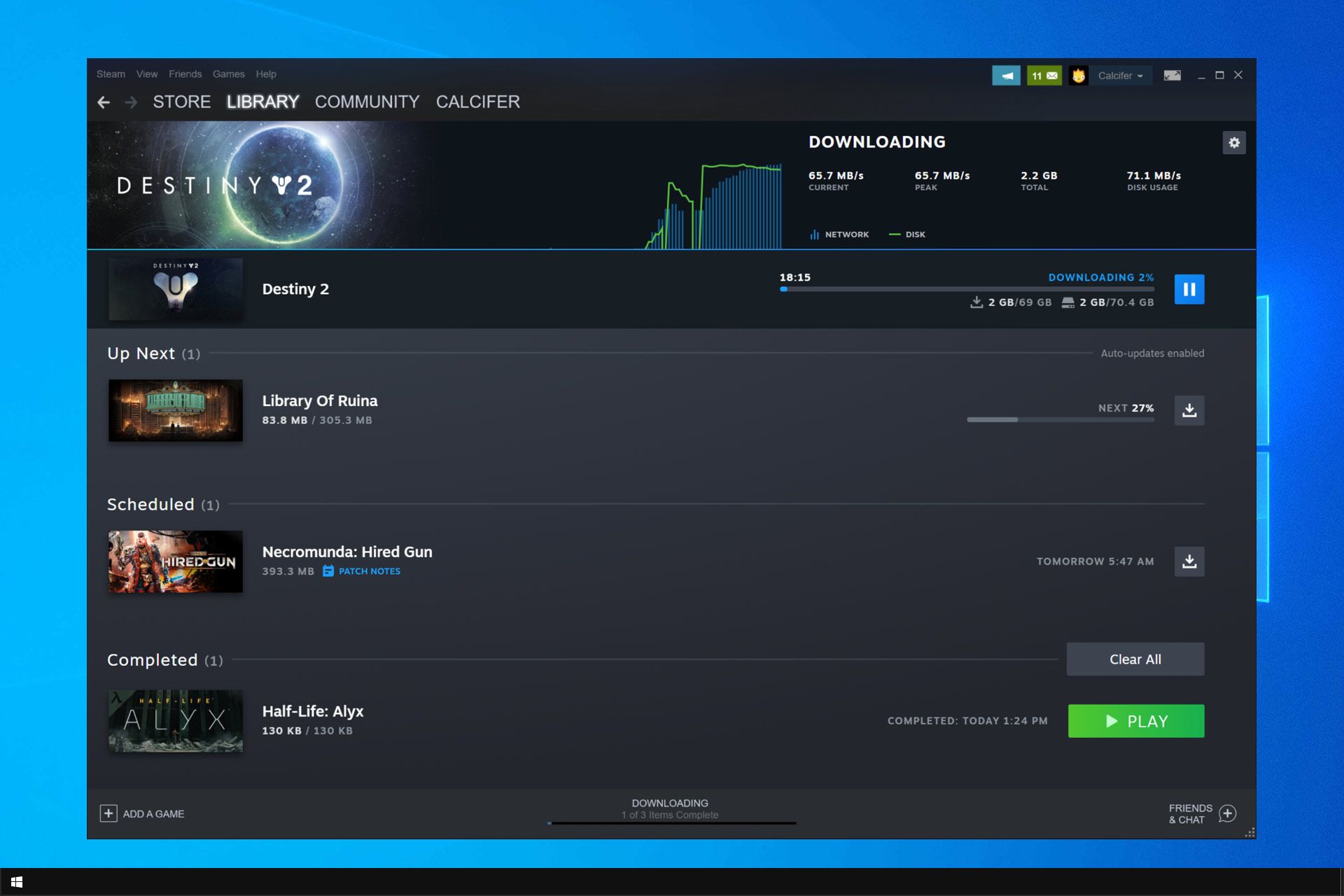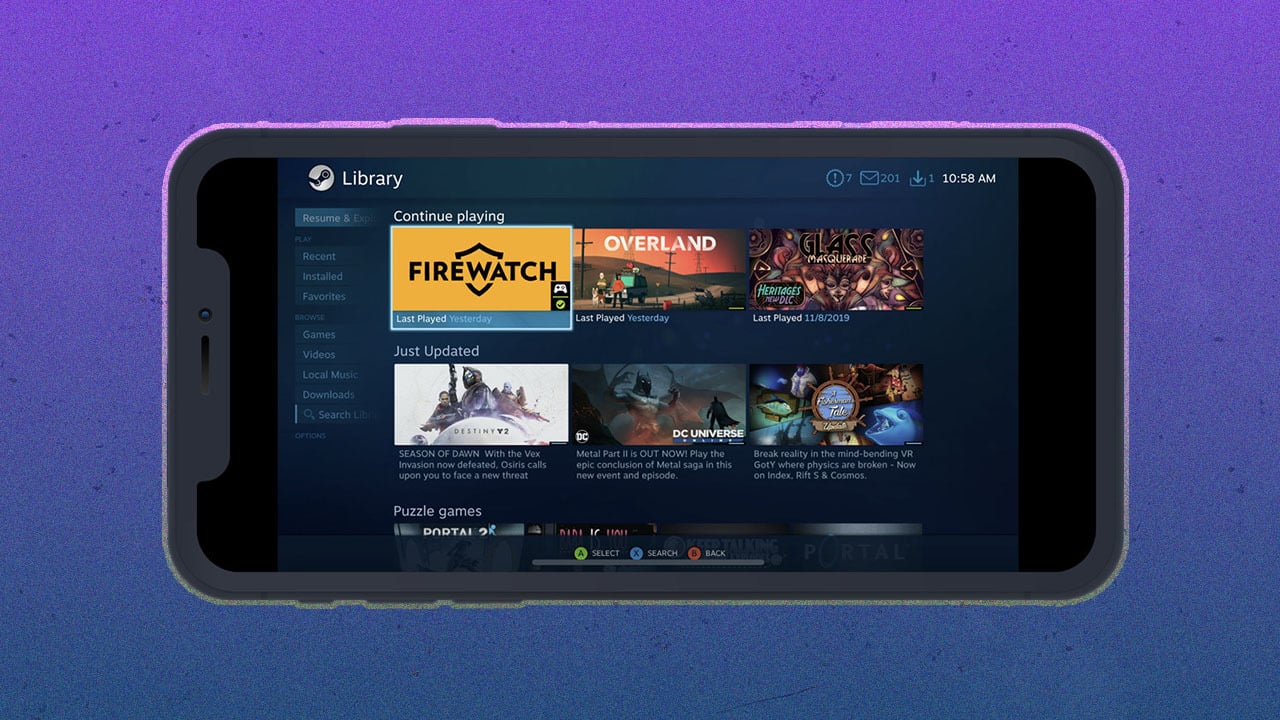Introduction
Welcome to the world of Steam, the leading digital distribution platform for PC gamers. If you are a Steam user, you may have encountered a common issue – slow download speeds. Waiting for games or updates to download can be frustrating, especially when you’re eager to jump into the action. Fortunately, there are several steps you can take to optimize your Steam download speeds and make the process faster and more enjoyable.
In this article, we will explore various methods to help you improve your Steam download speeds in 2016. From simple tweaks to more advanced settings, we’ll guide you through step-by-step instructions to maximize your download performance. Whether you have a slow internet connection or simply want to make the most of your available bandwidth, these tips will help you get back to gaming in no time.
Keep in mind that the effectiveness of these methods may vary depending on your specific setup and internet connection. It’s worth trying different approaches to find the ones that work best for you. So, without further ado, let’s dive into the world of faster Steam downloads!
Check Your Internet Connection
The first step in troubleshooting slow Steam downloads is to check your internet connection. A weak or unstable connection can significantly impact your download speeds. Here are a few things you can try:
1. Run a Speed Test: Use an online speed test tool like Ookla’s Speedtest or Google’s Internet Speed Test to measure your internet connection’s download and upload speed. If your speeds are significantly lower than what you’re paying for, contact your internet service provider (ISP) to address the issue.
2. Reboot Your Router and Modem: Sometimes, simply restarting your router and modem can resolve connection issues and improve download speeds. Turn both devices off, wait for a couple of minutes, and then turn them back on.
3. Use a Wired Connection: If you’re currently using a Wi-Fi connection, consider connecting your PC directly to the router with an Ethernet cable. Wired connections tend to be more stable and provide faster speeds, especially if your Wi-Fi signal is weak.
4. Check for Network Congestion: If you’re experiencing slow download speeds during peak hours, it’s possible that your internet service is affected by network congestion. Try downloading during off-peak hours to see if that improves your speeds.
5. Check for Background Downloads: Make sure that there are no other devices or applications on your network consuming a significant amount of bandwidth. Pause any ongoing downloads or updates on other devices to free up bandwidth for Steam.
By ensuring that your internet connection is running smoothly and optimizing it for Steam downloads, you can eliminate one potential bottleneck and make way for faster speeds.
Change Your Download Region
Another effective method to speed up your Steam downloads is to change your download region. Steam automatically selects the closest download server based on your location, but sometimes these servers can become overloaded or experience connectivity issues. Switching to a different download region can help alleviate these issues. Here’s how:
1. Open Steam Settings: Launch the Steam application and go to the “Steam” menu in the top left corner. From the drop-down menu, select “Settings.”
2. Go to Downloads: In the Settings window, click on the “Downloads” tab located on the left-hand side.
3. Change Download Region: Look for the “Download Region” section and click on the drop-down menu. From the list of available regions, select a different region that is geographically close to you but not necessarily the closest one.
4. Apply Changes and Restart Steam: Click “OK” to save the changes. Steam will prompt you to restart the client for the changes to take effect. Close and reopen Steam to complete the process.
Changing your download region can help bypass congested servers and connect to a server with faster speeds. Experiment with different regions to find the one that works best for you. Keep in mind that selecting a region too far away could lead to higher latencies, so try to strike a balance between proximity and performance.
If you’re still experiencing slow download speeds after changing your download region, you can try switching back to the default region or selecting a different one to see if it makes a difference. Keep in mind that the availability of servers and their performance may change over time, so it’s worth revisiting this setting periodically to ensure optimal download speeds.
Limit Background Applications
Running numerous applications in the background can consume valuable system resources and impact the performance of your Steam downloads. By limiting the number of background applications, you can allocate more resources to Steam and potentially improve download speeds. Here are some steps to help you manage background applications:
1. Close Unnecessary Programs: Before starting your Steam download, close any unnecessary programs running in the background. This includes web browsers, media players, and any other applications that are not essential for your current tasks.
2. Disable Startup Programs: Some applications automatically start up when you boot your computer, consuming resources and potentially slowing down your system. Disable startup programs that you don’t need by accessing the System Configuration utility (Windows) or the Login Items settings (Mac).
3. Manage Background Services: In addition to applications, background services can also impact performance. Use the Task Manager (Windows) or Activity Monitor (Mac) to identify resource-intensive services and temporarily disable or close them while your Steam download is in progress.
4. Adjust Power Settings: On laptops, your power settings may affect system performance. Set your power plan to “High Performance” to ensure your computer is running at its maximum potential during the download process.
5. Use Game Mode or Performance Mode: Some operating systems offer performance-focused features like Game Mode (Windows) or Performance Mode (Mac). Activating these modes can prioritize system resources for gaming and help optimize Steam download speeds.
By minimizing the number of background applications and optimizing your system settings, you can improve the resources available to Steam, allowing it to download content more efficiently and potentially increasing your download speeds.
Clear Steam Download Cache
If your Steam download speeds are still slow, it may be worth clearing the download cache, as accumulated data in the cache can sometimes cause performance issues. The Steam download cache stores temporary files that can become corrupted over time. Clearing the cache can help resolve download speed issues. Here’s how to do it:
1. Open Steam Settings: Launch the Steam application and go to the “Steam” menu in the top left corner. From the drop-down menu, select “Settings.”
2. Go to Downloads: In the Settings window, click on the “Downloads” tab located on the left-hand side.
3. Clear Download Cache: Look for the “Clear Download Cache” button and click on it. A confirmation dialog box will appear to ensure you want to proceed with clearing the cache. Click “OK” to confirm.
4. Restart Steam: Close the Steam client completely and then relaunch it. The cache will be cleared, and Steam will rebuild the necessary files and folders.
By clearing the download cache, you eliminate any potential corruption that may be hindering your download speeds. This can help optimize the performance of Steam and potentially improve your download experience.
After clearing the cache, monitor your download speeds to see if there’s an improvement. If not, move on to the next method to continue troubleshooting and optimizing your Steam download speeds.
Update Graphics Drivers
Outdated or faulty graphics drivers can impact the performance of your system, including your Steam download speeds. Updating your graphics drivers to the latest version can potentially resolve any compatibility or performance issues. Here’s how to update your graphics drivers:
1. Identify Your Graphics Card: Determine the make and model of your graphics card. On Windows, you can do this by opening the Device Manager (right-click on the Start button and select Device Manager) and expanding the “Display adapters” category. On a Mac, click on the Apple menu, select “About This Mac,” and then click on “System Report.”
2. Visit the Manufacturer’s Website: Once you have the information about your graphics card, visit the manufacturer’s website. For example, if you have an NVIDIA card, go to the NVIDIA website.
3. Download the Latest Drivers: Look for the drivers section on the website and search for the latest drivers for your specific graphics card model and operating system. Download the appropriate drivers.
4. Install the Drivers: Run the downloaded file to install the drivers. Follow the on-screen instructions to complete the installation process.
5. Restart Your Computer: After the installation is complete, restart your computer to apply the changes and ensure the updated drivers are properly loaded.
Updating your graphics drivers ensures that your system is equipped with the latest software enhancements and bug fixes. This can potentially improve the compatibility and performance of your graphics card, leading to smoother overall system performance and faster Steam downloads.
If you’re still experiencing slow download speeds after updating your graphics drivers, don’t worry. There are still more methods to explore. Let’s move on to the next section and continue troubleshooting to optimize your Steam download speeds.
Disable Windows Updates
Windows updates are important for the security and stability of your operating system. However, during a Steam download, these updates can consume valuable bandwidth and impact your download speeds. Temporarily disabling Windows updates while you’re downloading games or updates on Steam can help improve your download speeds. Here’s how:
1. Open Windows Update Settings: Go to the Windows Start menu and type “Windows Update Settings” in the search bar. Click on the corresponding result to open the Windows Update settings.
2. Pause Updates: In the Windows Update settings, click on the “Pause updates for 7 days” option. This will temporarily pause Windows updates for a week. If you need more time, you can extend the pause by clicking on “Advanced options” and adjusting the setting accordingly.
3. Set Active Hours: Windows allows you to set active hours, during which it will avoid installing updates. To do this, go back to the Windows Update settings and click on “Change active hours.” Set the start and end time for your active hours, typically during the time when you’re not actively using your computer.
4. Disable Automatic Updates: If you want more control over Windows updates, you can disable automatic updates temporarily. In the Windows Update settings, click on “Advanced options.” Under the “Choose how updates are installed” section, select “Notify to schedule restart.” This will allow you to manually install updates at your convenience.
Disabling Windows updates while you’re downloading games or updates on Steam can ensure that your bandwidth is fully dedicated to your Steam downloads. Just remember to re-enable Windows updates once you’re done with your Steam downloads to keep your system up to date.
If disabling Windows updates didn’t result in faster download speeds, don’t worry. We still have more methods to try. Let’s move on to the next section and continue optimizing your Steam download speeds.
Exclude Steam from Antivirus Scans
Antivirus programs play a crucial role in protecting your computer from malware and other security threats. However, sometimes these programs can mistakenly flag Steam files as malicious, leading to performance issues and slow download speeds. To prevent this from happening, you can exclude Steam and its associated files from antivirus scans. Here’s how:
1. Open Your Antivirus Program: Launch your antivirus software by clicking on its icon in the system tray or by searching for it in the Start menu.
2. Access the Exclusion/Exceptions Settings: Look for the settings related to exclusions or exceptions. This may vary depending on the antivirus software you’re using, but it is usually located in a section like “Settings,” “Options,” or “Preferences.”
3. Add Steam to the Exclusion/Exceptions List: In the exclusion/exceptions settings, add the Steam installation folder and its associated files to the list. The Steam installation folder is typically located in “C:\Program Files (x86)\Steam” for 64-bit systems or “C:\Program Files\Steam” for 32-bit systems. You may also need to add any other folders related to Steam, such as the SteamApps folder where games are stored.
4. Save the Changes: Once you’ve added the necessary exclusions for Steam, save the changes in your antivirus settings.
By excluding Steam from antivirus scans, you prevent unnecessary interference with the Steam client and its download process. This can potentially lead to improved download speeds and a smoother overall experience.
It’s important to note that excluding Steam from antivirus scans may slightly reduce security. However, Steam itself has built-in security measures, including regular updates and its own verification system, to ensure the safety of downloaded files. If you’re concerned, you can periodically scan your Steam files manually after the download is complete.
If excluding Steam from antivirus scans didn’t yield the desired results, don’t worry. There are still additional methods to try. Let’s move on to the next section and continue optimizing your Steam download speeds.
Disable Steam Auto-Updates
Steam has a built-in feature that automatically updates your games and the Steam client itself. While this ensures that you have the latest versions and bug fixes, it can also impact your download speeds, especially when multiple updates are queued. Disabling the auto-update feature can help prioritize your current download and potentially speed up the process. Here’s how to disable auto-updates in Steam:
1. Open Steam Settings: Launch the Steam application and go to the “Steam” menu in the top left corner. From the drop-down menu, select “Settings.”
2. Go to Downloads: In the Settings window, click on the “Downloads” tab located on the left-hand side.
3. Change Auto-Update Settings: Look for the “Download restrictions” section and click on the drop-down menu below it. From the options, select “Only update this game when I launch it” or “Only update this game when I launch it, and show a confirmation dialog for additional content.” This will prevent automatic updates for games until you specifically choose to launch them.
4. Disable Automatic Updates for the Steam Client: To disable automatic updates for the Steam client itself, deselect the box that says “Always keep this game up to date” in the “Automatic game updates” section.
5. Save the Changes: Click “OK” to save the changes in your Steam settings.
Disabling auto-updates in Steam allows you to have more control over when updates occur. By preventing automatic updates while you’re downloading games or updates, you ensure that all resources are dedicated to the ongoing download, potentially resulting in faster speeds.
Remember to manually update your games and the Steam client when you’re ready by launching them or checking for updates in the Steam library.
If disabling auto-updates didn’t significantly improve your download speeds, don’t worry. There are still further methods to explore. Let’s move on to the next section and continue optimizing your Steam download speeds.
Use a Wired Connection
If you’re using a Wi-Fi connection to download games on Steam, switching to a wired connection can often lead to faster and more stable download speeds. While Wi-Fi is convenient, it is more prone to interference and signal fluctuations, which can affect download performance. By using an Ethernet cable to connect your computer directly to the router, you can minimize these issues and potentially optimize your Steam downloads. Here’s how to set up a wired connection:
1. Check for an Available Ethernet Port: Ensure that your computer and router both have available Ethernet ports. Most modern computers and routers have these ports, usually located at the back.
2. Connect Your Computer to the Router: Use an Ethernet cable to connect your computer to one of the available Ethernet ports on your router. Plug one end of the cable into the Ethernet port on your computer and the other end into an Ethernet port on your router.
3. Disable Wi-Fi: To ensure your computer is using the wired connection, disable Wi-Fi on your computer. This can usually be done through the Network settings on your operating system.
4. Restart Your Computer and Router: After making the physical connection, restart both your computer and router. This will ensure that the changes are properly applied, and your computer recognizes the wired connection.
Using a wired connection bypasses the interference and signal limitations often encountered with Wi-Fi connections. This can lead to more stable and faster download speeds, allowing you to enjoy your games without the frustration of slow downloads.
If using a wired connection is not possible or doesn’t significantly improve your download speeds, there are still a few more methods to explore. Let’s move on to the next section and continue optimizing your Steam download speeds.
Conclusion
Slow download speeds on Steam can be frustrating, but by implementing the tips and techniques mentioned in this article, you can significantly improve your download experience. From checking your internet connection to optimizing your settings, each step plays a vital role in enhancing your Steam download speeds.
First, ensure that your internet connection is stable and running at its optimal speed. Consider changing your download region if necessary, as this can help bypass congested servers. Additionally, limiting background applications and clearing the Steam download cache can free up resources and eliminate potential bottlenecks.
Don’t forget to keep your graphics drivers up to date, as outdated drivers can impact system performance. Excluding Steam from antivirus scans can prevent interference that may hinder download speeds. Finally, consider using a wired connection to minimize signal fluctuations and maximize download stability.
Remember, these methods are not guaranteed to work equally well for everyone, as download speeds can vary depending on various factors. It’s important to experiment with different approaches and find the combination that works best for your specific setup.
By implementing these techniques, you can optimize your Steam download speeds and get back to gaming faster than ever before. Enjoy the seamless, high-speed downloads and immerse yourself in the world of gaming without the frustration of waiting for files to download.
Happy gaming and speedy downloads!

























